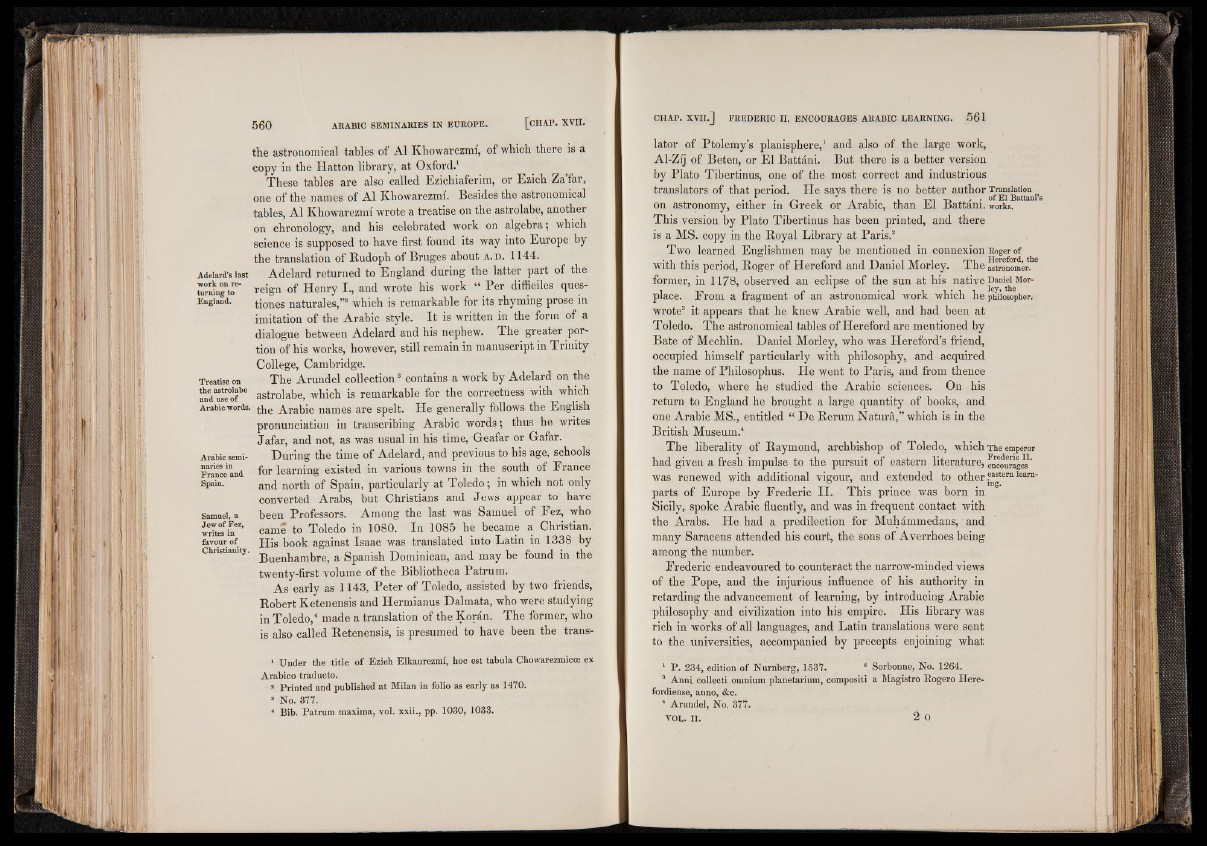
the astronomical tables of A1 Khowarezmi, of which there is a
copy in the Hatton library, at Oxford.1
These tables are also called Ezichiaferim, or Ezieh Za far,
one of the names of A1 Khowarezmi. Besides the astronomical
tables, A1 Khowarezmi wrote a treatise on the astrolabe, another
on chronology, and his celebrated work on algebra 5 which
science is supposed to have first found its way into Europe by
the translation of Rudoph of Bruges about a .d . 1144.
Adeiard’s last Adelard returned to England during the latter part of the
r ± 0gntr reign of Henry I., and wrote his work “ Per difficiles ques-
Engiaud. tiones natural es,”2 which is remarkable for its rhyming prose in
imitation of the Arabic style. It is written in the form of a
dialogue between Adelard and his nephew. The greater portion
of his works, however, still remain in manuscript in Trinity
College, Cambridge.
Treatise on The Arundel collection3 contains a work by Adelard on the
Ind^serf1*6 astrolabe, which is remarkable for the correctness with which
Arabic-words. t}le Arabic names are spelt. He generally follows the English
pronunciation in transcribing Arabic words; thus he writes
Jafar, and not, as was usual in his time, Geafar or Gafar.
Arabic semi- During the time of Adelard, and previous to his age, schools
Franceand for learning existed in various towns in the south of France
Spain. anq north of Spain, particularly at Toledo; in which not only
converted Arabs, but Christians and Jews appear to have
Samuel, a been Professors. Among the last was Samuel of Fez, who
S i n “ ’ came to Toledo in 1080. In 1085 he became a Christian,
favour of jjjs book against Isaac was translated into Latin in 1338 by
hnstiamty. |„.rj a Spanish Dominican, and may be found in the
twenty-first volume of the Bibliotheca Patrum.
As early as 1143, Peter of Toledo, assisted by two friends,
Robert Ketenensis and Hermianus Dalmata, who were studying
in Toledo,4 made a translation of the Koran. The former, who
is also called Retenensis, is presumed to have been the trans-
1 Under the title o f Ezieh Elkaurezmi, hoc est tabula Chowarezmicce ex
Arabico traducto.
2 Printed and published at Milan in folio as early as 1470.
8 No. 377.
4 Bib. Patrum maxima, vol. xxii., pp. 1030, 1033.
lator of Ptolemy’s planisphere,1 and also of the large work,
Al-Zij of Beten, or El Battäni. But there is a better version
by Plato Tibertinus, one of the most correct and industrious
translators of that period. He says there is no better author Translation
i a t * i t^i t > / • o fE lB a tta n is on astronomy, either m (jrreek or Arabic, than h i l ±>attani. works.
This version by Plato Tibertinus has been printed, and there
is a MS. copy in the Royal Library at Paris.2
Two learned Englishmen may be mentioned in connexion Roger of
with this period, Roger of Hereford and Daniel Morley. The Stronomerte
former, in 1178, observed an eclipse of the sun at his native Daniel Morr
. ley, the place. From a fragment of an astronomical work which he philosopher,
wrote3 it appears that he knew Arabic well, and had been at
Toledo. The astronomical tables of Hereford are mentioned by
Bate of Mechlin. Daniel Morley, who was Hereford’s friend,
occupied himself particularly with philosophy, and acquired
the name of Philosophus. He went to Paris, and from thence
to Toledo, where he studied the Arabic sciences. On his
return to England he brought a large quantity of books, and
one Arabic MS., entitled “ De Rerum Natura,” which is in the
British Museum.4
The liberality of Raymond, archbishop of Toledo, which The emperor
had given a fresh impulse to the pursuit of eastern literature, ^courages’
was renewed with additional vigour, and extended to other i^tern leam"
parts of Europe by Frederic II. This prince was born in
Sicily, spoke Arabic fluently, and was in frequent contact with
the Arabs. He had a predilection for Muhammedans, and
many Saracens attended his court, the sons of Averrhoes being
among the number.
Frederic endeavoured to counteract the narrow-minded views
of the Pope, and the injurious influence of his authority in
retarding the advancement of learning, by introducing Arabic
philosophy and civilization into his empire. His library was
rich in works of all languages, and Latin translations were sent
to the universities, accompanied by precepts enjoining what
1 P . 234, edition o f Nürnberg, 1537. 2 Sorbonne, No. 1264.
3 Anni collecti omnium planetarium, compositi a Magistro Eogero Here-
fordiense, anno, &c.
4 Arundel, No. 377.
VOL. I I . 2 O